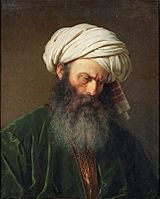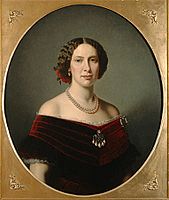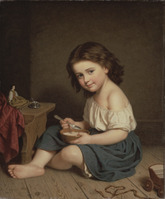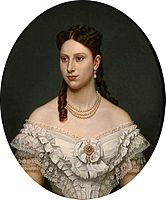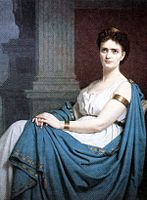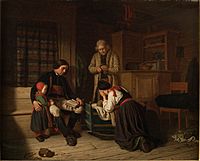Amalia Lindegren facts for kids
Quick facts for kids
Amalia Lindegren
|
|
|---|---|
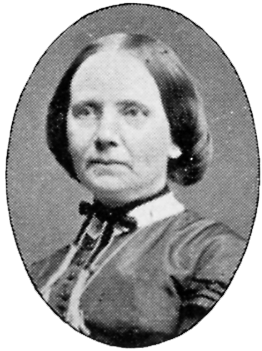 |
|
| Born |
Amalia Lindegren
22 May 1814 Stockholm, Sweden
|
| Died | 27 December 1891 (aged 77) Stockholm, Sweden
|
| Nationality | Swedish |
Amalia Euphrosyne Lindegren (born May 22, 1814 – died December 27, 1891) was a famous Swedish artist and painter. She became a member of the Royal Swedish Academy of Arts in 1856.
Contents
Biography
Amalia Lindegren was born in Stockholm, Sweden. Her mother, Anna Catharina Lindgren, passed away when Amalia was young. After this, Amalia was adopted by the wealthy widow of Benjamin Sandels, who was believed to be her biological father.
Amalia's childhood was not easy. She often felt like a charity case for richer families. Many people believe that her later paintings of sad young girls were inspired by these early experiences.
Early Talent and Education
Amalia showed artistic talent from a young age. She started by drawing and selling her artwork. In 1839, she began painting with oil colors.
By 1842, she was studying art with Sofia Adlersparre. The very next year, she showed her paintings in her first art exhibition.
Studying at the Academy
In 1846, a well-known artist and teacher named Carl Gustaf Qvarnström noticed Amalia's drawings. He was very impressed by her skill. Thanks to his help, Amalia became one of only four women accepted to study at the Royal Swedish Academy of Arts in 1849. The other women were Lea Ahlborn, Agnes Börjesson, and Jeanette Möller.
At that time, women could not formally study at the Academy in the same way as men. They needed special permission. It wasn't until 1864 that women were officially allowed to study there on equal terms.
Studies Abroad
In 1850, Amalia made history. She became the first woman student to receive a scholarship from the Academy to study art in Paris. In Paris, she learned from famous teachers like Léon Cogniet and Ange Tissier.
Later, she continued her studies in other European cities. In 1854, she went to the Alte Pinakothek in Münich. From 1854 to 1855, she studied in Rome. She also showed her art at the World Exhibition in Paris in 1856. She returned to Sweden that same year and visited Paris again in 1859.
Personal Life
Amalia Lindegren knew many important cultural figures of her time. These included writers like Fredrika Bremer and Wendela Hebbe. However, Amalia was known for being a quiet and humble person. She was very introverted and did not talk much at social events.
People described her as someone who "lived a retiring life without making a fuss about herself." She worked very hard and was rarely satisfied with her own artwork. Amalia never married and focused entirely on her painting. She passed away in Stockholm.
Artist
Amalia Lindegren's art style is connected to the Düsseldorf School of painting. She painted many portraits and scenes from everyday life, known as genre paintings. She was inspired by artists like Adolph Tidemand and Hans Gude.
One painting she sent home from her studies in Paris was a scene of everyday life. The Academy was surprised by her choice of subject, but it showed her great skill.
Popular Paintings
In 1857, Amalia traveled to Dalarna, a region in Sweden. Her paintings from this trip became very popular. She often painted scenes of peasant life in Dalarna. Many of these paintings featured sad young girls. These works were done in a sentimental style and are thought to reflect her own childhood experiences.
Her most famous painting is probably Lillans sista bädd, which means 'The Final Rest of The Little One'. This painting was shown in Paris in 1867, in Philadelphia in 1876, and in Chicago in 1893.
Portrait Painter
Amalia was also a highly respected portrait painter. She was praised for her ability to capture how people truly looked. She was considered one of the most fashionable portrait painters of her time, alongside Uno Troili. She even painted a portrait of the queen, Louise of the Netherlands.
Recognitions
Amalia Lindegren received several honors for her artistic achievements. In 1853, she became an "agré." This was a title given to younger artists who showed great promise and followed the style of the Royal Swedish Academy of Arts. In 1856, she became a full member of the Academy.
She was also an honorary member of the British Society of Women Artists in London. Additionally, she was awarded the Litteris et Artibus, a Swedish royal medal given for outstanding artistic contributions.
Gallery
See also
 In Spanish: Amalia Lindegren para niños
In Spanish: Amalia Lindegren para niños


